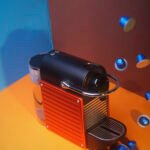Vertuo-also
In art school, I was never a particularly a good sculptor or painter, but I absolutely loved all the art history classes.
Having done the Nespresso Pixie photo, I thought it’d be fun to pretend I’m in art school again and create something interesting.
From a product design POV, the Nespresso Vertuo is that introduces a new format that’s bigger, pricier, and more complex, without delivering a noticeably superior cup of coffee. From a design perspective, it’s an object that prioritizes consumer capture over elegance or efficiency.
At the same time, it was a gift from a friend who had to fight off a security guard (long story..) so it is much loved and appreciated.
Anyways, to the shoot:
The camera used was, as usual, GFX 50S II. For lens, I decided to use the GF35-70 zoom. Strobe and TT600 angled at either side of the camera, with strobe at lowest power and flash at /16 power.
The initial rational for using the zoom was because I wanna play with the different focal length, and approach the shoot as an architectural. Like a bauhaus or brutalist building. But the test shots looked too on the nose and gimmicky. So for the rest of the shoot, it’s permanently stuck at the tele end, 70mm.
The top of the mind photographer influence for this image was László Moholy-Nagy
Compared to the very human photographs of Henri Cartier Bresson, I’ve always ignored this Hungarian painter and photographer. LM-N’s works seemed reserved and celebral to me versus HCB’s which has more emotional impact. But somehow he is the first artist I think of when I started making this photo.
Giorgio Morandi (a.k.a. The Patron Saint of Still Lifes)
Morandi was famous for painting still life. Bottles. Bowls. Jugs. Muted, contemplative. A protest against modern life. Maybe I’m protesting meekly against the crass cash-grab philosophy behind these coffee machines.
Honorable mentions:
These are various other inspirations/ideas that crossed my mind but I think I didn’t quite successfully put across.
Piet Mondrian and the De Stijl Gang
The bold red machine against the electric blue and orange background owes a debt to Mondrian and the De Stijl movement. They believed in stripping things down to primary colors and geometric purity. You won’t find a perfect grid in my photo, but the spirit’s there: a sense of order, clarity, and high-contrast joy.
Also, the triangle of shadow cutting across the wall? Total accident. But once I saw it, I kept it—it felt like a cheeky wink from the ghost of Theo van Doesburg.
James Turrell, Dan Flavin, and the Cult of Light
That beam of angled shadow actually wasn’t there. It was a last minute addition. You can tell that it looked wrong because it is at a different angle from the where the direction of the main light. It’s a nod to artists who treat light like sculpture. Turrell builds temples of light. Flavin used fluorescent tubes like crayons. I had one strobe and a colored wall, but I tried to channel that same reverence. The shadow became a character in the scene—quiet, angular, deliberate.
Bauhaus Meets Memphis
So, in terms of sensibility, the image sits somewhere between Bauhaus and Memphis Group, with maybe a coffee stop in Copenhagen.
The Bauhaus bits are obvious: the machine itself is a monolithic geometric form. It looks bulky as only bauhaus can. There’s a geometry to the setup that might have converted the tea-drinking Walter Gropius to coffee.
But the Memphis influence is what really snuck in. The play of bold colors, shapes, and a slightly absurd devotion to styling a coffee machine like this. This is my take on Ettore Sottsass’s typewriter that looked like Lego bricks.
And I can certainly see it on display someday: The machine on Carousell, the photograph in the Tate Museum…
 Previous post
Espresso: Tossed, not Stirred
Previous post
Espresso: Tossed, not Stirred
 Next post
Waimangu
Next post
Waimangu

